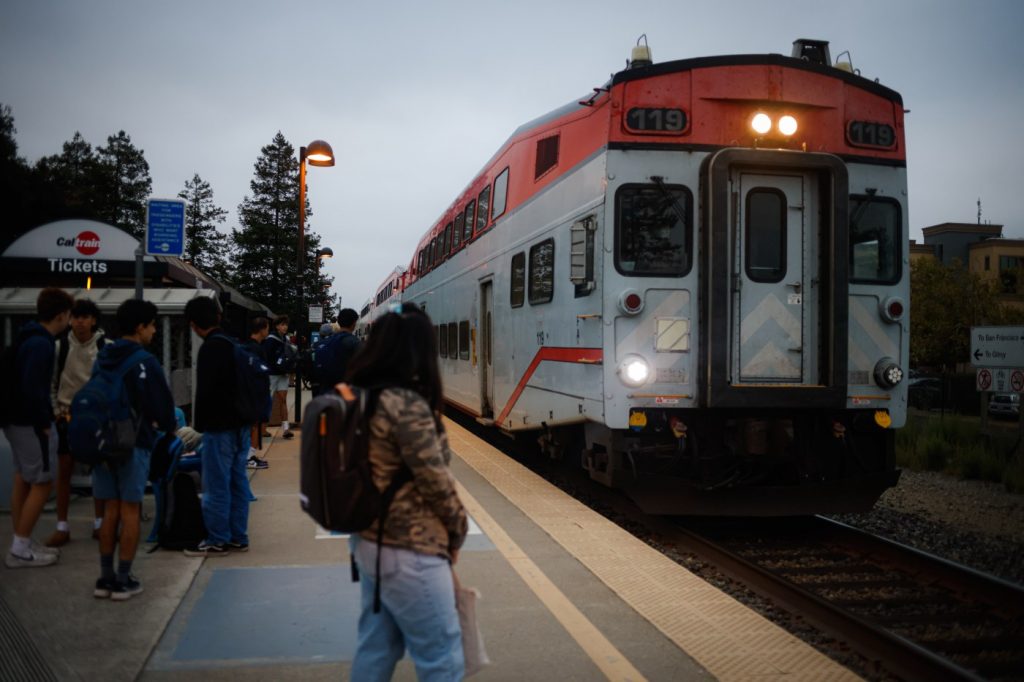Gleaming red and white hulls of electric trains will whir into stations across the South Bay and Peninsula this weekend, whisking passengers along electrified lines with cleaner, more reliable transit.
That is, unless they live south of San Jose.
From Diridon Station to Gilroy, the familiar, hulking diesel locomotives will rumble along for years to come.
After years of planning and construction, Caltrain is fully launching rail electrification this weekend, showing off trains that will provide faster service and smoother, quieter rides with better Wi-Fi and outlets at every seat. Because the electric trains accelerate and slow down much faster than diesel trains, service will increase by 20%, offering between 75 and 104 weekday trips from most stations.
But even as Caltrain electrifies its fleet and retools its schedules, the more than 100,000 residents of south Santa Clara County will be left behind to rely on diesel trains that offer a fraction of the daily trips and no weekend service. While local leaders hope to push for more and better train options for those residents, the path forward is limited by funding issues and an obscure, 30-year-old contract dictating the ownership of the train lines in the South Bay.
“It’s really unfortunate that the electrification will end in San Jose and not be a part of South County,” said Morgan Hill Mayor Mark Turner. “We need more transit … we are constantly struggling with how to do more with less.”
While South County passengers used to be able to get on one train and ride it to or from San Francisco, they will now need to swap trains in San Jose. Caltrain, however, says the transfers will be coordinated so passengers can simply walk across the platform once their train comes in.
Additionally, the stations south of Tamien station in San Jose only offer four round trips (for a total of eight trips a day) and do not offer weekend service.
Local leaders say these issues are part of a history of south county being left behind in transit. Gilroy Mayor Marie Blankley, who serves on the board of Valley Transportation Authority, recalled seeing a Santa Clara County transportation study that simply excluded areas south of San Jose. In recent years, she and other local advocates have formed partnerships with local transit providers and pushed to include south county in the conversation. Last September, that advocacy bore fruit when Caltrain introduced a fourth train to Gilroy using Measure B funds from VTA, bringing them up from three round trips.
Still, Caltrain has struggled with low ridership, down around 60% this summer compared to the months before the COVID-19 pandemic, the company is expected to operate in the red in the next fiscal year. Ridership in South County hovers at just over a tenth of that of San Jose alone.
While Blankley acknowledges that growth is in part driven by ridership, she holds that more trains would bring along more riders, noting that the addition of the fourth train saw ridership in the South County jump up by a third. “I’m convinced people would ride if it made sense to do so. When it is convenient, when it works for you, you want to use it,” said Blankley. “The service has to be one that you can reasonably count on. And Gilroy and Morgan Hill have not had that yet.”
While elsewhere train service continues past midnight, the last train back to Gilroy leaves San Francisco at 5:19 p.m. and San Jose at 6:21 p.m. Several commuters say it is too early for them, forcing them to find other alternatives.
That’s true for Rob Mataiti, who works at Amazon in Milpitas and says that while he enjoys the convenience of the train in the morning, he finishes work around 8 p.m. and relies on his wife to pick him up. “I usually just go one way,” said Mataiti. “Later trains … that would be great, definitely.”
Though Sam Sargent, director of Strategy and Policy for Caltrain, admits that financial restrictions make expanding in south county more difficult, he says Caltrain has discussed finding public funding with the help of the VTA to bring a fifth train to south county.
Caltrain also received grant funding from the California Transportation Commission to secure battery-powered electric trains that can operate on the tracks between San Jose and Gilroy, though the project is expected to take until 2028 to reach pilot stages.
Despite these aspirations, Caltrain has limited flexibility. The tracks between southern San Jose and Gilroy are owned by Union Pacific, restricting their freedom to electrify the tracks, and the agreement allowing Caltrain to run on those tracks limits them to five outgoing and five incoming trains on the weekdays, with no weekend service.
Related Articles
Get ready to raise the woof at San Jose’s Bark in the Park
Ride Caltrain and SamTrans for free, Bay Area airports to get upgrades, new Martinez shuttle
St. Francis High School opens new Welcome Center with a blessing
Caltrain seeks to increase ridership with new $1 youth fare
Judge refuses to toss lawsuit over 1¼ miles of Richmond railroad alleged to be at risk for derailments
While planning for electrification, Caltrain did not approach Union Pacific seeking to electrify the tracks south of San Jose.
After several attempts to secure an interview with a representative from Union Pacific, they did not respond to questions about the current cap on service and whether they would be willing to explore options for electrification or allow for expanded rail service in the future.
“Union Pacific works with passenger agencies to develop plans for passenger operations in the state of California,” said Meg Siffring, manager of Corporate Communications and Media Relations at Union Pacific, in an email exchange. “Agreements are required for expansion of rail service to passengers. We do not currently have an agreement in place with Caltrain.”
Sargent did not say whether there was an ability to renegotiate the agreement but noted that despite its restrictions, the agreement was essential for even the current level of service.
Despite the slower progress for South County, some are bullish on the prospects of pushing for better service, including Representative Zoe Lofgren, whose district includes parts of San Jose as well as Gilroy and Morgan Hill. “Union Pacific has a well-earned reputation nationwide of being difficult to deal with on the part of municipalities,” she said.
Currently, California High Speed Rail Authority is in negotiations with Union Pacific to get the right of way to electrify and modernize the corridor between Gilroy and San Jose. While the arrival of high speed rail depends on funding, the negotiations offer a glimmer of opportunity for future transit in the South Bay.
“We do need better transit than we have right now,” said Lofgren. “We’re not willing to accept the status quo.”


